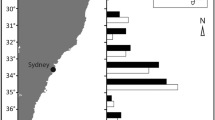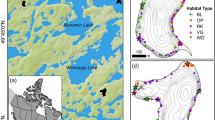Abstract
In the Laurentian Great Lakes, diurnal migration of fishes into and out of coastal wetlands is well documented, but movement among wetlands is more poorly understood despite important conservation implications. We assessed movements of typically resident species using mark-recapture. For seven species, only 9 (6.2 %) individuals were recaptured in a wetland different from where they were tagged. Conversely, based on radio-tracking, typically migratory Northern Pike (Esox lucius) moved among wetlands that were 1.4 km apart, although some moved as far as 3.9 km. Results suggest that while the majority of fishes remain in a single wetland throughout the year, a large top predator requires multiple wetlands over comparatively larger areas. Currently, coastal wetlands in Ontario are evaluated for protection if greater than 2 ha, but smaller proximate marshes (within 750 m) can be grouped into complexes. Our results demonstrate that while this distance likely protects fish habitat for most resident fishes, it fails to cover the observed movement patterns of Northern Pike. A modification to this grouping rule for coastal wetlands would delineate more ecologically appropriate complexes by incorporating movement among wetlands by top predators. Delineating larger wetland complexes would protect critical fish habitat and populations in the Great Lakes.



Similar content being viewed by others
References
Angel JR, Kunkel KE (2010) The response of Great Lakes water levels to future climate scenarios with an emphasis on Lake Michigan-Huron. J Great Lakes Res 36:51–58
Cederholm CJ, Kunze MD, Murota T, Sibatani A (1999) Pacific salmon carcasses: essential contributions of nutrients and energy for aquatic and terrestrial ecosystems. Fisheries 24:6–15
Chow-Fraser P (2006) Development of the water quality index (WQI) to assess effects of basin-wide land-use alteration on coastal marshes of the Laurentian Great Lakes. In: Simon T, Stewart TP (eds) Coastal Wetlands of the Laurentian Great Lakes: Health. Habitat and Indicators. Authorhouse, Bloomington, pp 137–166
Cook MF, Bergersen EP (1988) Movements, habitat selection, and activity periods of northern pike in Eleven Mile Reservoir, Colorado. Trans Am Fish Soc 117:495–502
Cooke SJ, Graeb B, Suski C, Ostrand KG (2003) Effects of suture material on incision healing, growth and survival of juvenile largemouth bass implanted with miniature radio transmitters: case study of a novice and experienced fish surgeon. J Fish Biol 62:1366–1380
Cooke SJ, Midwood JD, Thiem JD, Klimley P, Lucas MC, Thorstad EB, Eiler J, Holbrook C, Ebner B (2013) Tracking animals in freshwater with electronic tags: past, present and future. Journal of Animal Biotelemetry 1:5
Cvetkovic M, Chow-Fraser P (2011) Use of ecological indicators to assess the quality of Great Lakes coastal wetlands. Ecol Indic 11:1609–1622
Cvetkovic M, Wei A, Chow-Fraser P (2010) Relative importance of macrophyte community versus water quality variables for predicting fish assemblages in coastal wetlands of the Laurentian Great Lakes. J Great Lakes Res 36:64–73
DeCatanzaro R, Chow-Fraser P (2011) Effects of landscape variables and season on reference water chemistry of coastal marshes of eastern Georgian Bay. Can J Fish Aquat Sci 68:1–45
Diana J, Mackay W (1977) Movements and habitat preference of northern pike (Esox lucius) in Lac Ste. Anne, Alberta. Trans Am Fish Soc 106:560–565
Fish P, Savitz J (1983) Variations in home ranges of largemouth bass, yellow perch, bluegills, and pumpkinseeds in an Illinois lake. Trans Am Fish Soc 112:147–153
Fracz A, Chow-Fraser P (2013) Impacts of declining water levels on the quantity of fish habitat in coastal wetlands of eastern Georgian Bay, Lake Huron. Hydrobiologia 702:1–19
Franklin AB, Noon BR, George TL (2002) What is habitat fragmentation? Stud Avian Biol 25:20–29
Gotelli N, Taylor C (1999) Testing metapopulation models with stream-fish assemblages. Evol Ecol Res 1:835–845
Hedges KJ, Koops MA, Mandrak NE, Johannsson OE (2010) Use of aquatic protected areas in the management of large lakes. Aquat Anim Health Res Inst Newsl 13:135–142
Hoey A, McCormick M (2006) Effects of subcutaneous fluorescent tags on the growth and survival of a newly settled coral reef fish, Pomacentrus amboinensis (Pomacentridae). Proceedings of the 10th International Coral Reef Symposium, 420–424
Jackson D, Peres-Neto P, Olden J (2001) What controls who is where in freshwater fish communities–the roles of biotic, abiotic, and spatial factors. Can J Fish Aquat Sci 58:157–170
Jacobus J, Webb PW (2006) Using fish distributions and behavior in patchy habitats to evaluate potential effects of fragmentation on small marsh fishes: a case study. J Great Lakes Res 31:197–211
Jepsen N, Aarestrup K (1999) A comparison of the growth of radio-tagged and dye-marked pike. J Fish Biol 55:880–883
Jepsen N, Beck S, Skov C, Koed A (2001) Behaviour of pike (Esox lucius L.) >50 cm in a turbid reservoir and in a clearwater lake. Ecol Freshw Fish 10:26–34
Jonsson B, Jonsson N, Hansen LP (2003) Atlantic salmon straying from the River Imsa. J Fish Biol 62:641–657
Jude D, Pappas J (1992) Fish utilization of Great Lakes coastal wetlands. J Great Lakes Res 18:651–672
Kobler A, Klefoth T, Wolter C, Fredrich F (2008) Contrasting pike (Esox lucius L.) movement and habitat choice between summer and winter in a small lake. Hydrobiologia 601:17–27
Koed A, Balleby K, Mejlhede P (2006) Annual movement of adult pike (Esox lucius L.) in a lowland river. Ecol Freshw Fish 15:191–199
Malone J, Forrester G, Steele M (1999) Effects of subcutaneous microtags on the growth, survival, and vulnerability to predation of small reef fishes. J Exp Mar Biol Ecol 237:243–253
McCairns R, Fox M (2004) Habitat and home range fidelity in a trophically dimorphic pumpkinseed sunfish (Lepomis gibbosus) population. Oecologia 140:271–279
Midwood JD, Chow-Fraser P (2012) Changes in aquatic vegetation and fish communities following 5 years of sustained low water levels in coastal marshes of eastern Georgian Bay, Lake Huron. Glob Chang Biol 18:93–105
Midwood JD, Rokitnicki-Wojcik D, Chow-Fraser P (2012) Development of an inventory of coastal wetlands for eastern Georgian Bay, Lake Huron. ISRN Ecology 2012:1–13. doi:10.5402/2012/950173
Ministry of Natural Resources (OMNR), No.50254. Peterborough, ON.
Mortsch L, Quinn F (1996) Climate change scenarios for Great Lakes Basin ecosystem studies. Limnol Oceanogr 41:903–911
Mouillot D (2007) Niche-assembly vs. dispersal-assembly rules in coastal fish metacommunities: implications for management of biodiversity in brackish lagoons. J Appl Ecol 44:760–767
Murphy S, Collins NC, Doka SE, Fryer BJ (2012) Evidence of yellow perch, largemouth bass and pumpkinseed metapopulations in coastal embayments of Lake Ontario. Environ Biol Fish 95:213–226
Noss R (1992) Issues of scale in conservation biology. In: Fiedler PL, Jain SK (eds) Conservation Biology: The Theory and Practice of Nature Conservation. Preservation and Management. Chapman & Hall, New York, pp 240–241
OMNR (2013) Ontario Wetland Evaluation System. Northern Manual, Ontario
Randall R, Minns C, Cairns V, Moore J (1996) The relationship between an index of fish production and submerged macrophytes and other habitat features at three littoral areas in the Great Lakes. Can J Fish Aquat Sci 53:35–44
Rogers K, White GC (2007) Analysis of movement and habitat use from telemetry data. In: Brown ML (ed) Analysis and interpretation of freshwater fisheries data. American Fisheries Society, Bethesda, Maryland, pp 625–676
Sale P (1998) Appropriate spatial scales for studies of reef-fish ecology. Austral Ecology 23:202–208
Scott WB, Crossman EJ (1998) Freshwater Fishes of Canada. Galt House Publications, Oakville, ON
Seilheimer T, Chow-Fraser P (2007) Application of the wetland fish index to northern Great Lakes marshes with emphasis on Georgian Bay coastal wetlands. J Great Lakes Res 33:154–171
Sellinger C, Stow C, Lamon E, Qian S (2008) Recent water level declines in the Lake Michigan − Huron System. Environ Sci Technol 42:367–373
Suski CD, Cooke SJ (2007) Conservation of aquatic resources through the use of freshwater protected areas: opportunities and challenges. Biodivers Conserv 16:2015–2029
Wei A, Chow-Fraser P, Albert D (2004) Influence of shoreline features on fish distribution in the Laurentian Great Lakes. Can J Fish Aquat Sci 61:1113–1123
Acknowledgments
Funding for this research was provided through grants from Georgian Bay Forever, Sierra Club Canada Foundation and the Ontario Ministry of Natural Resources through the Canada-Ontario Agreement. JDM was supported through the Ontario Graduate Scholarship program. Mary Muter, Mark Trudeau, and Denny Hare provided invaluable support in accessing the study locations. Robert Lennox and Maja Cvetkovic provided comments on early drafts of this manuscript and MC also provided extensive field assistance during the summer of 2010. Bob Christensen, Chris Biberhofer, John Paul Leblanc, and Dale Midwood also provided invaluable help in the field. Finally, we thank two anonymous reviewers who provided very helpful comments that improved the current manuscript considerably.
Author information
Authors and Affiliations
Corresponding author
Rights and permissions
About this article
Cite this article
Midwood, J.D., Chow-Fraser, P. Connecting Coastal Marshes Using Movements of Resident and Migratory Fishes. Wetlands 35, 69–79 (2015). https://doi.org/10.1007/s13157-014-0593-3
Received:
Accepted:
Published:
Issue Date:
DOI: https://doi.org/10.1007/s13157-014-0593-3




